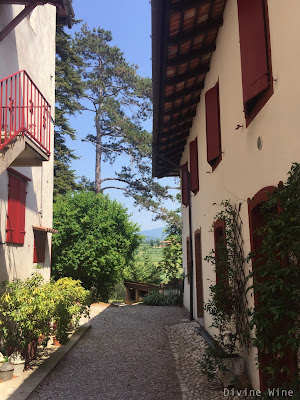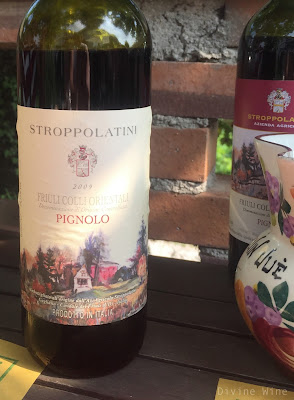 |
| Stroppolatini's court yard reflects Italian sense of beauty. |
Stroppolatini produces 100% Pignolo
While Pignolo
is the most glorious of Friulian local black grapes, it is also the toughest one to
handle. It produces very low yields (only 50% of the yields of Merlot), is messy to
work with due to its staining pigments, and demands extensive maturation to
show its potential. It is no surprise that producers tend to be slightly
apprehensive about planting Pignolo, and it is not widely produced in its home
area. On top of that, drinking and selling young wines have always dominated
the Friulian wine culture. Hence, Pignolo has been either drank too young,
while astringent and still hiding its aromatic potential, or it has been ”cut”
with other grapes to soften it, but also loosing its varietal beauty in the
process.
Fortunately,
there are exceptions to these rules: Stroppolatini produces 100% Pignolo. At
the moment they sell out the 2010 vintage, and still, Federico Stroppolatini
considers the wine to be very young - it is only starting to show its
potential. We were privileged to be able
to vertically taste three consecutive vintages of Stroppolatini Pignolo, and to
experience in practise the evolution of this exceptional wine.
Stroppolatini
Pignolo 2011
This wine
being still in the process of maturation, Federico kindly offers us tasting
samples straight from the barrel. The intensely deep ruby red colour and the
finesse of the aromatics on the nose immediately communicate how very big this
wine is. The aromas are different from anything I have smelled before: there
are wild forest berries, mostly red berries such as wild raspberries and cranberries,
and an elegant and very feminine perfume aroma. This aroma of face powder or
talcum powder is extraordinary, and in my experience completely unique to
Pignolo. The red berry and powdery nuances are supported by deeper red, almost
black fruit character of plums, and black pepper spice.
What about
the palate then? Well, as expected, this young Pignolo wine is definitely
aggressive on the palate. Drying and mouth pinching tannin combined with bold
acidity promises aging potential for years and decades to come. Also the
concentrated fruit and well-integrated alcohol promise a glorious future for
this wine. However, drinking it now would be utter waste of a beautiful
product, because its structure is only starting to develop and its flavour
potential is still mostly hidden. Nevertheless, this young wine has an intense
and long finish that lingers for minutes.
 |
| Stroppolatini Pignolo 2010. |
Stroppolatini
Pignolo 2010
Although vintage
2010 can drink now, Federico thinks it would benefit from many more years of
aging to show its best qualities. I absolutely agree. Compared to the 2011
vintage, this wine shows more raspberry fruit as well as more development. Tertiary
aromas of cedar and tobacco are intertwined with the delightful powdery, floral
pignoloish perfume. What a bouquet! While the tannin still dominates on the
palate, there is now more roundness to its quality. But make no mistake; there
is still definite muscle and aggression to the structure! And the finish, oh,
the finish. A complex aromatic sequence keeps opening up for ages.
 |
| Stroppolatini Pignolo 2009. |
Stroppolatini
Pignolo 2009
This wine
is where the potential of this grape is truly revealed. It is an outstanding wine. The intense colour is
now already turning towards garnet, and the nose has more fruity, raspberry
intensity, nevertheless remaining still very floral, powdery and elegantly
feminine. Federico brings up the peculiar way Pignolo typically ages: while
wines usually become less and less fruity with age, Pignolo appears to reveal
its fruit more and more! Somehow its berry aromas are liberated while the tannin
becomes softer.
This is absolutely true. I find 2009 vintage to be even more
abundant in raspberry and cranberry flavours compared to the previous wines.
Notably, the palate is now showing a beautiful balance. The plentiful tannin
has become integrated and remarkably rounder, only slightly pinching the
tongue. I can only imagine where this wine would go in ten years of time: it
would probably become powdered raspberry velvet supported by a cascade of
developed aromas. Already now, the aftertaste is exceptional. I greatly enjoy
the paradox this wine offers: on one hand it is feminine and elegant in its
flavours, on the other hand it is shamelessly powerful and tannic. Pignolo is
an iron princess!
wow. That is a difficult grape to grow.
ReplyDeleteAbsolutely! I can only imagine the work. Still, the results are worth it, I have to say!
ReplyDelete